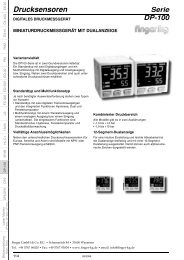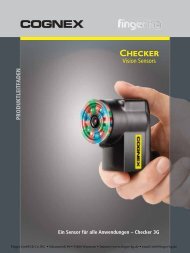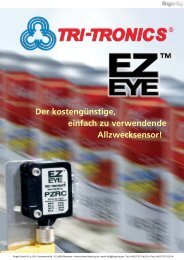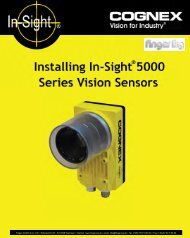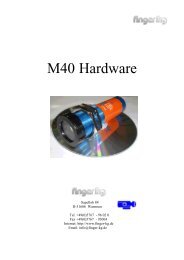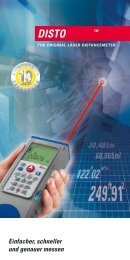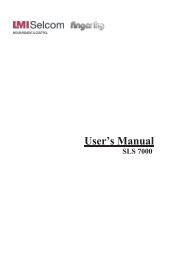TRIANGULATION LASER SENSORS, LDS603 Series Rev. G (26.06 ...
TRIANGULATION LASER SENSORS, LDS603 Series Rev. G (26.06 ...
TRIANGULATION LASER SENSORS, LDS603 Series Rev. G (26.06 ...
You also want an ePaper? Increase the reach of your titles
YUMPU automatically turns print PDFs into web optimized ePapers that Google loves.
<strong>TRIANGULATION</strong> <strong>LASER</strong> <strong>SENSORS</strong>, <strong>LDS603</strong> <strong>Series</strong><br />
03h Network address 1…127 (default — 1)<br />
04h Rate of data transfer through serial<br />
port<br />
05h Laser intensity level 0…31<br />
06h Number of averaged values 1…128, (default — 1)<br />
07h Reserved<br />
08h Lower byte of the sampling period<br />
09h Higher byte of the sampling period<br />
0Ah Lower byte of maximum integration<br />
time<br />
0Bh Higher byte of maximum integration<br />
Page 7/22<br />
time<br />
0Ch Lower byte for the beginning of<br />
analog output range<br />
0Dh Higher byte for the beginning of<br />
analog output range<br />
0Eh Lower byte for the end of analog<br />
output range<br />
0Fh Higher byte for the end of analog<br />
output range<br />
<strong>Rev</strong>. G (<strong>26.06</strong>.2008)<br />
1…192, (default — 4) specifies data transfer rate in increments of 2400<br />
baud; e.g., 4 means the rate of 4×2400=9600baud. (NOTE: max baud<br />
rate = 460800)<br />
1) 10…65535, (default — 500)<br />
the time interval in increments of 0.01 ms with which sensor automatically<br />
communicates of results on streaming inquiry (priority of<br />
sampling = 0);<br />
2) 1…65535, (default — 500)<br />
divider ratio of trigger input with which sensor automatically commu-<br />
nicates of result on streaming inquiry (priority of sampling = 1)<br />
2…65535, (default — 200) specifies the limiting time of integration by<br />
CMOS-array in increments of 1mks<br />
0…4000h, (default — 0) specifies a point within the absolute range of<br />
transducer where the analog output has a minimum value<br />
0…4000h, (default — 4000h) ) specifies a point within the absolute<br />
range of transducer where the analog output has a maximum value<br />
10h Time lock of result 0…255, specifies of time interval in increments of 5 mс<br />
11…16h Reserved<br />
17h Lower zero point<br />
0…4000h, (default — 0) specifies beginning of absolute coordinate sys-<br />
18h Higher byte zero point<br />
tem.<br />
19…1Ch Reserved<br />
20h Data transfer rate via CAN interface 10…200, (by default — 200) specifies data transmission rate in increments<br />
of 5 000 baud, for example, the value of 50 gives the rate of 50*5<br />
000= 250 000 baud.<br />
22h Low byte of standard identifier 0…7FFh,(by default — 7FFh) specifies standard CAN identifier<br />
23h High byte of standard identifier<br />
24h 0th byte of extended identifier<br />
25h 1 st byte of standard identifier<br />
26h 2 nd 0…1FFFFFFFh, (by default — 1FFFFFFFh) specifies extended CAN<br />
identifier CAN<br />
byte of extended identifier<br />
27h 3 rd byte of standard identifier<br />
28h CAN interface identifier 1 — extended identifier;<br />
0 — standard identifier .<br />
8.11. NOTE:<br />
1) All values are given in binary form.<br />
2) Base distance and range are given in millimeters.<br />
3) The value of the result transmitted by a sensor (D) is so normalized that 4000h (16384) corresponds<br />
to a full range of the sensor (S in mm), therefore, the result in millimeters is obtained by the<br />
following formula:<br />
X=D*S/4000h (mm). (1)<br />
4) On special inquiry (05h), the current result can be latched in the output buffer where it<br />
will be stored unchanged up to the moment of arrival of request for data transfer. This inquiry can<br />
be sent simultaneously to all sensors in the net in the broadcast mode in order to synchronize data<br />
pickup from all sensors.<br />
5) When working with the parameters, it should be borne in mind that when power is OFF<br />
the parameter values are stored in nonvolatile FLASH-memory of the sensor. When power is ON,<br />
the parameter values are read out to RAM of the sensor. In order to retain these changes for the next<br />
Finger GmbH & Co. KG • Schamerloh 84 • 31606 Warmsen • Internet: www.finger-kg.de • email: info@finger-kg.de



